Abstract
Significant uranium exploration breakthroughs have been achieved in the eolian deposits of the uranium reservoirs in the southwestern part of the Ordos Basin. The redox environment remains a crucial factor in controlling the migration and precipitation of uranium. This study, through rock mineralogical observations and hydrocarbon gas composition analysis, combined with the regional source rock and basin tectonic evolution history, reveals the characteristics of the reducing medium and the mineralization mechanisms involved in uranium ore formation. The Lower Cretaceous Luohe Formation uranium reservoirs in the study area exhibit a notable lack of common reducing media, such as carbonaceous debris and pyrite. However, the total hydrocarbon gases in the Luohe Formation range from 2967 to 20,602 μmol/kg, with an average of 8411 μmol/kg—significantly higher than those found in uranium reservoirs elsewhere in China, exceeding them by 10 to 100 times. Due to the absence of other macroscopically visible organic matter, hydrocarbon gases are identified as the most crucial reducing agent for uranium mineralization. These gases consist predominantly of methane and originate from the Triassic Yanchang Formation source rock. Faults formed during the Indosinian, Yanshanian, and Himalayan tectonic periods effectively connect the Cretaceous uranium reservoirs with the oil and gas reservoirs of the Triassic and Jurassic, providing pathways for the migration of deep hydrocarbon fluids into the Cretaceous uranium reservoirs. The multiphase tectonic evolution of the Ordos Basin since the Cenozoic has facilitated the development of faults, ensuring a sufficient supply of reducing media for uranium reservoirs in an arid sedimentary context. Additionally, the “Replenishment-Runoff-Drainage System” created by tectonic activity promotes a continuous supply of uranium- and oxygen-bearing fluids to the uranium reservoirs, resulting in a multi-energy coupling mineralization effect.
1. Introduction
Uranium mines are an important source of clean energy and strategic resources, with diverse types and complex origins [1,2,3,4,5,6,7]. Sandstone-type uranium deposits are non-fossil energy mineral resources that are enriched within sandstone bodies through fluid action. Soviet scholars referred to them as “hydrothermal uranium deposits” [8]. In the classical model of interlayer oxidation zone uranium mineralization, the redox environment within the sandstone uranium reservoirs is a key factor influencing the migration and precipitation of uranium [8,9,10,11,12,13,14]. The reducing medium is essential for the formation of sandstone-type uranium deposits, as it constrains the development of interlayer oxidation zones. The spatial coupling between this reducing medium and the oxidation zones creates a redox transition zone, which is the optimal location for uranium mineralization [15,16]. Thus, it can be said that the exploration and prediction of sandstone-type uranium deposits essentially involve evaluating the distribution patterns of the reducing medium [11].
Deep hydrocarbon fluids, such as oil and natural gas, have been extensively reported to participate in uranium mineralization in various basins, including Qaidam, Junggar, Bayin Gol, Ordos, Erlian, and Songliao [16,17,18,19,20,21,22,23,24,25,26,27]. However, the contribution of hydrocarbon fluids to uranium mineralization has been questioned in these regions due to the common presence of carbonaceous debris and pyrite—two critical reducing media for sandstone-type uranium deposits [10,28,29,30,31,32,33,34,35,36,37].
Recent uranium exploration findings in the Pengyang–Zhenyuan area of the southwestern Ordos Basin indicate that the reducing media within its uranium reservoirs are distinctly different from those in other regions. The Lower Cretaceous Luohe Formation uranium reservoirs show a significant lack of carbonaceous debris and pyrite; however, acid-soluble hydrocarbon results demonstrate that their hydrocarbon gas content is far higher than that in uranium reservoirs across China, clearly indicating that the reducing medium contributing to uranium mineralization originates from deep hydrocarbon fluids [38,39,40,41]. Nonetheless, the sources of these hydrocarbon fluids remain unclear, as the Cretaceous uranium reservoirs are underlain by Paleozoic Ordovician and Carboniferous–Permian formations, as well as multiple sets of Mesozoic Triassic and Jurassic source rocks, still leaving the mineralization mechanisms uncertain. In light of this, this paper employs microscopic rock mineralogical observations and hydrocarbon gas composition analyses, synthesizing regional geophysical interpretations along with the regional source rocks and basin tectonic evolution history. It aims to reveal the sources and migration pathways of hydrocarbon fluids within the uranium reservoirs, exploring the temporal and spatial coupling between hydrocarbon fluids and uranium and oxygen-bearing fluids, thereby providing theoretical insights for regional sandstone-type uranium exploration and prediction.
2. Regional Geological Background
The Ordos Basin, located in central China, covers an area of approximately 250,000 km2 and is renowned for its coexistence of multiple mineral resources, including oil, gas, coal, and uranium [17]. The basin can be divided into six structural units: the Yimeng Uplift, the western thrust belt, the Tianhuan Depression, the Shaanxi North Slope, the Jinxi Anticline Zone, and the Weibei Uplift (Figure 1a). The western thrust belt experienced intense compressional thrusting activity during the late Jurassic, resulting in widespread faulting and localized structural development (Figure 1a). The Tianhuan Depression, influenced by the western thrust belt, exhibits an asymmetric syncline structure with a steep western flank and a gently dipping eastern flank. The basin’s basement comprises metamorphic rock formations from the Archean to Lower Proterozoic, while the cover mainly consists of Cenozoic strata. Mesozoic strata are well-developed within the basin, rich in energy resources such as coal (coalbed methane), oil (gas), and sandstone-type uranium deposits (Figure 1a,b).
During the late early Cretaceous, the southwestern Ordos Basin underwent significant uplift and erosion due to the Yanshan movement. This movement persisted until the late Cretaceous, resulting in the absence of Upper Cretaceous strata within the basin (Figure 1c). Sandstone-type uranium deposits are extensively developed in the basin, primarily distributed in the northern region around Hangjinqi–Dongsheng and the southern region around Binxian–Hancheng (Figure 1a) [42,43,44,45,46,47]. The main uranium-bearing strata are the Middle Jurassic Zhiluo Formation and the Lower Cretaceous Luohe Formation (Figure 1b). A large number of source rocks are distributed beneath the Mesozoic uranium-bearing rock series (Figure 1a) [48,49,50,51]. Previous studies have suggested that the Triassic Yanchang Formation serves as the primary hydrocarbon source rocks and reservoirs, and the secondary migration of hydrocarbons formed the Jurassic hydrocarbon reservoirs (Figure 1b) [20,49,50].
The study area is situated within the Tianhuan Depression in the southwestern Ordos Basin, where uranium mineralization is primarily found in the thick sandstone of the Lower Cretaceous Luohe Formation, with minor uranium occurrences also identified in the Jingchuan and Luohandong Formations. The Luohe Formation in the study area primarily consists of interbedded aeolian and fluvial sediments, characterized by the development of sandstone bodies. The uranium deposits are distributed at depths ranging from 400 to 1100 m (Figure 2 and Figure 3), with mineralization in the Pengyang region reaching depths of up to 1400 m (Figure 3; [38]). The uranium bodies generally exhibit a tabular form, with some appearing lens-shaped. Uranium mineralization primarily occurs within gray fine sandstones adjacent to red sandstones and yellow sandstones (Figure 2 and Figure 3).

Figure 2.
Borehole column and logging curves in Zhenyuan area, southwest Ordos Basin. nc/kg·h—Nanocoulombs per kilogram per hour.
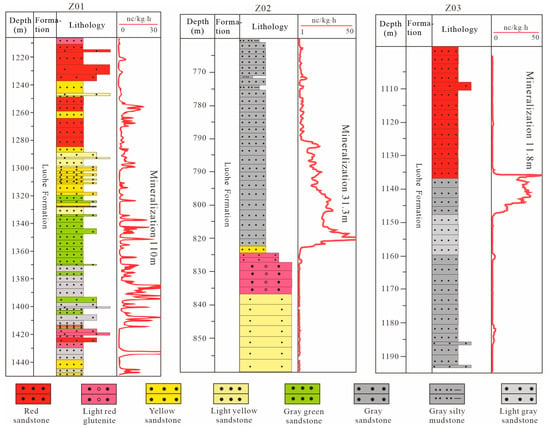
Figure 3.
Borehole column and logging curves in Pengyang area, southwest Ordos Basin [38].
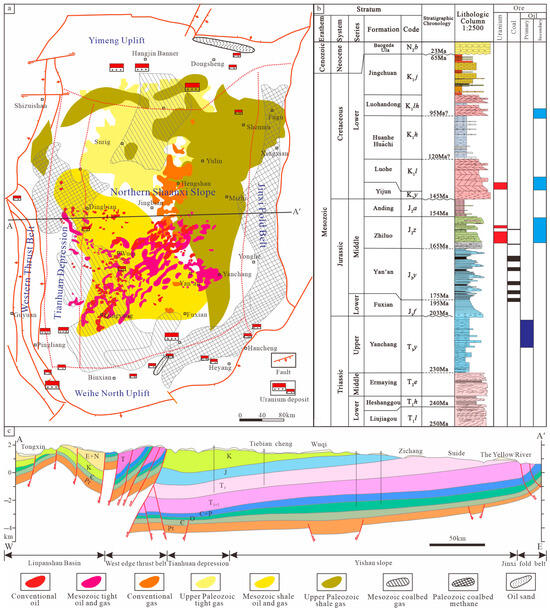
Figure 1.
(a) Distribution map of multiple energy and mineral resources in the Ordos Basin. (b) Composite column map of Meso-Cenozoic strata in southwestern Ordos Basin [52]. (c) Geological profile characteristics of the Ordos Basin. Primary—Source rocks and initial migration. Secondary—Secondary migration of oil and gas reservoirs. Pt—Proterozoic; Є—Cambrian; O—Ordovician; C+P—Carboniferous–Permian; T1+2—Early Middle Triassic; T3—Late Triassic; J—Jurassic; K—Cretaceous; E+N—Paleogene–Neogene.
3. Sample Collection and Testing
Core and thin-section samples were primarily collected from the uranium-bearing strata of the Luohe Formation within the study area. The study of uranium mineralogy involved microscopic observations of the altered mineral assemblages in the Luohe Formation, followed by scanning electron microscopy (SEM), backscattering, and energy dispersive spectroscopy to analyze the symbiotic relationships of uranium minerals. Microscopic observations and SEM analyses were conducted at the National Key Laboratory for Collaborative Green Exploitation of Terrestrial Shale Oil with Multi-Resource Synergy at Northeast Petroleum University. The optical microscope used was a German Leica DM4P, and the SEM was a TESCAN VEGA-LMS manufactured in the Czech Republic, operating at an accelerating voltage of 15–20 kV. The energy dispersive spectroscopy and backscattering detectors were provided by Oxford Instruments with the X-maxN spectrometer.
Samples for hydrocarbon gas analysis were collected from the core samples of the Jingchuan, Luohandong, Huanhe, and Luohe Formations within the study area. The sample processing involved natural air drying, crushing, and then sieving through a 40-mesh screen to ensure homogeneity. A 50 g aliquot of the sample was placed in a flask, and hydrochloric acid was added to decompose the carbonate minerals, releasing gases while removing carbon dioxide. Once the acid digestion was complete, a specific volume of gas was extracted for testing hydrocarbon gas component concentrations. A calibration curve was plotted using the external standard method (R2 > 0.999), and the content was calculated by correcting to the standard state using the ideal gas equation. Quality control involved blank experiments (subtracting background values < 50 μL/kg), parallel sample analysis (RSD < 5%), and spiked recovery experiments (90%~110%). Error control was achieved by checking the aeration apparatus for air tightness (flow rate ≤ 50 mL/min), thoroughly absorbing CO2 with saturated NaOH, ensuring uniform sample crushing, and regularly calibrating the injection volume of the chromatograph (RSD < 1%) and the detector response factor to prevent environmental hydrocarbon contamination and ensure analytical accuracy. The analytical testing was conducted at the Analysis and Testing Center of the Nuclear Industry 203 Research Institute, using an Agilent 6820 gas chromatograph for the hydrocarbon component analysis. The analysis included methane (C1), ethane (C2), propane (C3), n-butane (nC4), isobutane (iC4), n-pentane (nC5), and isopentane (iC5), with an analytical error of less than 5%. The results are presented in Table S1.
4. Results
4.1. Petrological Characteristics
The Luohe Formation uranium reservoir in the study area exhibits diverse geochemical rock types. Lithologies include purple-red medium-coarse sandstones (Figure 4a), yellow medium sandstones (Figure 4b), pale yellowish-gray fine sandstones (Figure 4c), and gray fine sandstones (Figure 4d). The predominant lithology is feldspathic quartz sandstone or lithic feldspathic quartz sandstone, with minor occurrences of lithic quartz sandstone and quartz sandstone. Neither carbonaceous debris nor abundant pyrite was observed in the field outcrops or core samples.

Figure 4.
Petrological characteristics of uranium reservoir sandstones in the Luohe Formation. (a) Purple-red medium-grained sandstone. (b) Yellow medium-grained sandstone; (c) Light yellow-gray fine-grained sandstone. (d) Gray fine-grained sandstone. (e) Microscopic image of medium-grained sandstone. (f) Quartzite debris observed under the microscope. (g) Microscopic image of dolomite debris. (h) Development of sandstone pores observed under scanning electron microscopy. (i) Secondary dolomite grains adhering to the surface of mineral grains. (j) Clay mineralization of feldspar.
Microscopic examination revealed that the mineral grains in the uranium-bearing sandstone primarily consist of quartz, feldspar, and minor lithic fragments (Figure 4e). The lithic fragments are mainly composed of quartzite (Figure 4f) and dolomite (Figure 4g). Heavy minerals include opaque metallic minerals and zircon, while the cementing material primarily consists of calcite with some silt. Localized occurrences of iron dolomite can also be observed (Figure 4g). The overall sorting of the rock is poor, with moderate roundness, and both compositional and structural maturity are at intermediate levels. The rock is characterized by particle support, with a pore-type cementation, where particles are in point contact, and a few secondary dissolution pores are developed within the rock.
Under scanning electron microscopy, the contact between sandstone grains appears loose, with well-developed intergranular pores, and localized feldspar dissolution pores are noted (Figure 4h). Authigenic quartz and dolomite grains are present between mineral grains and on grain surfaces, with the dolomite exhibiting a good crystalline form, appearing as microcrystalline aggregates (Figure 4i). Many grains show alteration features, with clay minerals predominantly adhered to their surfaces (Figure 4j). No common reducing media such as carbonaceous debris or pyrite were observed under either microscopic or scanning electron microscopy.
4.2. Characteristics of Uranium Mineral Distribution
Scanning electron microscopy (SEM) analysis reveals that uranium minerals are primarily located at the edges of sandstone clastic particles or within the pores between clastic grains (Figure 5a,b). Some uranium minerals are distributed within the dissolution pores of mineral or lithic particles (Figure 5c,d). The uranium mineral particles exhibit a clustered or speckled distribution, with irregular shapes and sizes predominantly ranging from 2 to 15 μm (Figure 5a,b). Some larger clusters can reach sizes of 50 to 100 μm (Figure 6a,b).
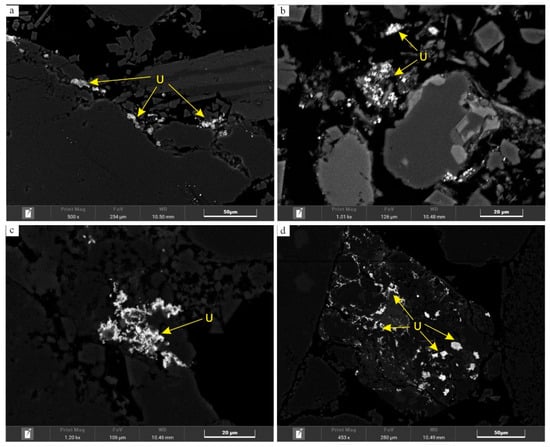
Figure 5.
Modes of occurrence of uranium minerals under scanning electron microscope. (a) Occurring at the margins of quartz grains. (b) Embedded within the pores of sandstone. (c) Present in the dissolved pores between quartz and feldspar. (d) Inhabiting the interstices within rock fragments.
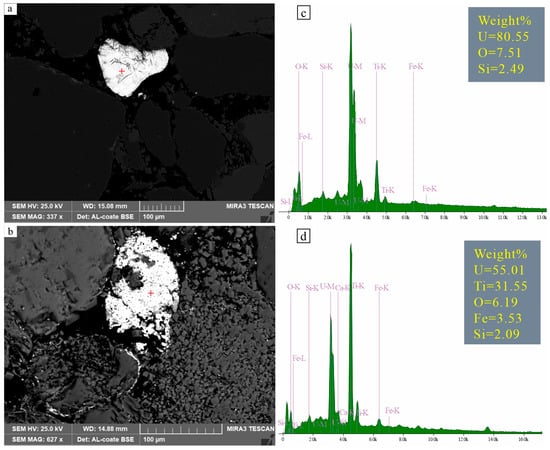
Figure 6.
Energy dispersive spectroscopy (EDS) analysis results of uranium minerals under scanning electron microscope (SEM). (a) Pitchblende (uranium oxide ore). (b) Titanium-bearing uranium minerals. (c) Spectral analysis of pitchblende. (d) Energy spectrum analysis of titanium uranium minerals.
The results of electron probe analysis indicate that the percentage of uranium in uranium minerals in the study area can reach as high as 84.75% (Figure 6a; Table S2). The uranium minerals are dominated by pitchblende with minor coffinite, and the main difference between them lies in the silicon (Si) content. Since the silica content in the study area is mostly below 5%, pitchblende is the predominant mineral. Some uranium minerals exhibit elevated titanium (Ti) content (Figure 6b), which is likely influenced by titanium oxides.
4.3. Geochemical Characteristics of Hydrocarbon Gases
The results of the acid digestion hydrocarbon analysis of sandstone indicate that the hydrocarbon gas component compositions are similar across the different sedimentary strata of the Cretaceous system in the study area. The main components are methane, ethane, and propane, while the concentrations of butane and pentane are relatively low (Supplementary Materials Table S1, Figure 7). Specifically, the Luohe Formation exhibits methane concentrations ranging from 2420 to 16,332 μmol/kg, with an average of 7313 μmol/kg; ethane concentrations range from 347 to 2951 μmol/kg, averaging 1105 μmol/kg; and propane concentrations range from 137 to 413 μmol/kg, with an average of 1014 μmol/kg. In the Huanhe Formation, methane concentrations range from 3911 to 10,529 μmol/kg, averaging 6949 μmol/kg; ethane ranges from 623 to 1416 μmol/kg, with an average of 960 μmol/kg; and propane ranges from 256 to 584 μmol/kg, averaging 341 μmol/kg. For the Luohandong Formation, methane concentrations range from 5182 to 10,111 μmol/kg, with an average of 7753 μmol/kg; ethane ranges from 779 to 1506 μmol/kg, averaging 1193 μmol/kg; and propane ranges from 321 to 612 μmol/kg, averaging 484 μmol/kg. In the Jingchuan Formation, methane concentrations range from 3597 to 8481 μmol/kg, averaging 5677 μmol/kg; ethane ranges from 566 to 1359 μmol/kg, with an average of 861 μmol/kg; and propane ranges from 245 to 548 μmol/kg, averaging 348 μmol/kg.

Figure 7.
Analysis results of hydrocarbon components in acid-decomposed sand bodies from the Lower Cretaceous Formation.
Regarding the total hydrocarbon gas content (C1–C5), the Luohe Formation has a maximum of 20,602 μmol/kg, a minimum of 2967 μmol/kg, and an average of 9215 μmol/kg. The total for the Huanhe Formation ranges from 4886 to 12,128 μmol/kg, with an average of 8411 μmol/kg; the Luohandong Formation ranges from 6392 to 12,422 μmol/kg, also averaging 8411 μmol/kg; and the Jingchuan Formation ranges from 4503 to 10,609 μmol/kg, averaging 7154 μmol/kg (Supplementary Materials Table S1). Overall, the total hydrocarbon gas content in the Luohe and Luohandong Formations is higher than that in the Huanhe and Jingchuan Formations, with the Jingchuan Formation exhibiting the lowest total hydrocarbons (Figure 8). In comparison, the hydrocarbon gas content in the Luohe Formation in the western Pengyang area is lower than that in the study area (Figure 8).
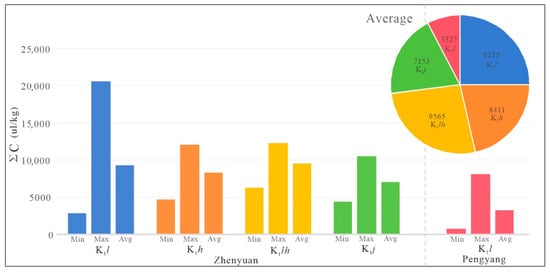
Figure 8.
Analysis chart of total hydrocarbon content via acidolysis in different sedimentary strata.
5. Discussion
5.1. Reducing Medium in the Uranium Reservoir
Field core observations and microscopic analyses indicate that the Luohe Formation uranium reservoir does not contain common reducing media such as carbonaceous debris and pyrite, and clay minerals are also quite rare (Figure 4a–j, Figure 5a–d and Figure 6a,b). Numerous studies have reported that hydrocarbon fluids, such as deep oil and gas, serve as reducing media in uranium mineralization processes within Mesozoic uranium basins in northern China [16,19,24,53]. For example, the Upper Youshashan Formation of the Neogene in the northwest of the Qaidam Basin [38,54], the Mesozoic–Cenozoic strata in the northern margin [2,55], the Jurassic Zhilu Formation in the Dongsheng area of the Ordos Basin [56], and the Jurassic Zhilu Formation in the Zaohuohao area, as well as the Cretaceous Sifangtai Formation in the western slope zone of the Songliao Basin [57] and the Cretaceous Yaojia Formation in the southern Tongliao area [19], have all demonstrated similar findings. The results of the acid digestion hydrocarbon analysis in the study area show that the total hydrocarbon gas content in the Zhenyuan area of the Ordos Basin is significantly higher than that in uranium reservoirs in other regions of China, reaching levels 10 to 100 times greater (Figure 9). Furthermore, the presence of substantial amounts of CH4 has been detected in the fluid inclusions of Luohe Formation sandstones within the Pengyang uranium deposit in the western part of the study area (Figure 10a,b; [40,58], which is consistent with the hydrocarbon analysis results obtained in this study (Figure 7). This evidence indicates that hydrocarbon fluids serve as the most significant reducing medium in the Cretaceous Luohe Formation uranium reservoir of the Zhenyuan area.
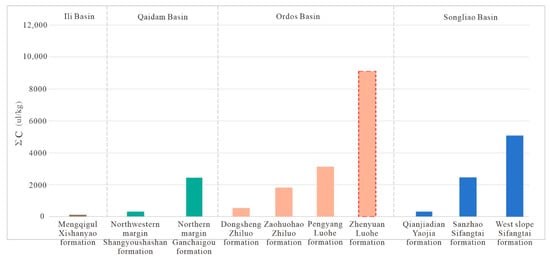
Figure 9.
The histogram of determination results for acid-degraded hydrocarbons in hydrocarbon gases from uranium reservoirs in different basins.

Figure 10.
Depicts microscopic images of hydrocarbon-bearing inclusions within the uranium reservoir of the Luohe Formation at the Pengyang uranium deposit, accompanied by laser Raman spectroscopic analyses [40,58]. (a,b) Fluorescence photos of hydrocarbon inclusions. (b) Titanium-bearing uranium minerals. (c,d) Laser Raman Analysis Results of Methane.
5.2. Source of Hydrocarbon Fluids
The Luohe Formation, as a typical uranium reservoir formed under eolian arid sedimentary conditions, lacks source rocks for hydrocarbons within its own strata. Therefore, the hydrocarbon fluids present in this formation originate from external sources. Beneath the Cretaceous sedimentary strata of the Ordos Basin, four sets of source rocks are developed: Ordovician Marine Source Rocks: Primarily mudstone-type, found in the Lower Paleozoic (Figure 11a). Carboniferous–Permian Coal-Forming Source Rocks: Developed in the Upper Paleozoic (Figure 11b). Triassic Yanchang Formation Source Rocks: Consisting mainly of dark mudstones from deep to semi-deep lake environments (Figure 12a). Lower Jurassic Yanan Formation: Characterized by lacustrine coal-forming source rocks (Figure 12b).
Biogenic gas, oil-type gas, and coal-type gas are the three main sources of hydrocarbon gases in the strata. The C1/∑C and C1/C2+ parameters can be used to identify the origin of hydrocarbon gases. In the Cretaceous sandstones of the study area, the C1/∑C values range from 0.72 to 0.87, and the C1/C2+ values range from 3.41 to 6.58, with all samples falling within the oil-type gas range (Figure 13a). This indicates that the hydrocarbon gases in the Cretaceous sandstones of the Zhenyuan area in the Ordos Basin are primarily oil-type gases generated from humic parent material. The dryness coefficient (C1/C1–5) is concentrated between 0.78 and 0.84, indicating typical wet gas, which suggests that the hydrocarbon gases are mainly in the thermal evolution stage from low maturity to high maturity, reflecting the characteristics of associated gas with crude oil.

Figure 11.
Distribution maps of Paleozoic source rocks in the Ordos Basin. (a) Distribution extent and hydrocarbon generation assessment of marine carbonate source rocks in the Majiagou Formation of the Ordovician system. (b) Cumulative thickness of coal seams in the Upper Paleozoic [59].
The C2/iC4 and C2/C3 parameters have a good correlation with natural gas maturity and can serve as qualitative indicators for gas maturity, distinguishing between kerogen cracking gas and crude oil cracking gas [59,60]. The C2/C3 values of the hydrocarbon gases in the Cretaceous sandstones of the Zhenyuan area range from 2.08 to 3.96, with an average of 2.68. The C2/iC4 values range from 31.10 to 78.59, with an average of 43.95, all greater than 10 (Figure 13b). These characteristics indicate that the hydrocarbon gases in the Cretaceous sandstone layer of the study area primarily originate from early crude oil cracking gas with a higher degree of thermal evolution.

Figure 12.
Distribution map of Mesozoic source rocks in Ordos Basin. (a) Triassic hydrocarbon accumulation distribution map. (b) Total thickness map of coal seams in the Yanan Formation of the Jurassic system.
The iC4/nC4 and iC5/nC5 values can be used to identify natural gas from different parent materials. When the iC4/nC4 value is less than 0.9 and the iC5/nC5 value is less than 0.85, the hydrocarbon gases are primarily crude oil cracking gas; otherwise, they are from the primary cracking of kerogen [61]. When the iC4/nC4 value is less than 0.8, the hydrocarbon gases are classified as oil-type gas; otherwise, they are coal-type gas [62]. In the study area, the iC5/nC5 values range from 0.63 to 0.85, with an average of 0.72, and all samples fall within the range of crude oil cracking gas (Figure 13c). The hydrocarbon gases have iC4/nC4 values ranging from 0.20 to 0.29, with an average of 0.25, indicating that the hydrocarbon gases in this sandstone layer are primarily oil-type gas.
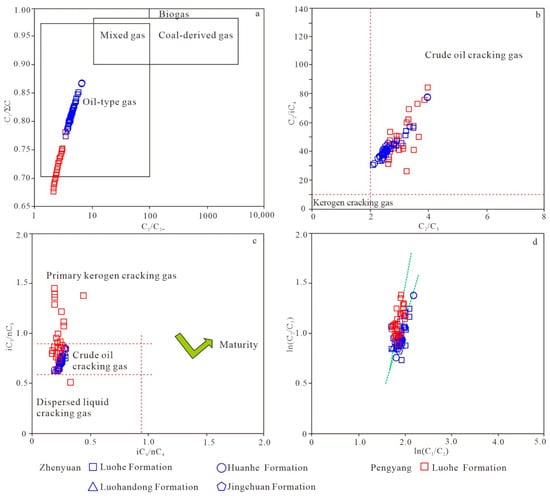
Figure 13.
Discrimination diagrams for hydrocarbon gas genesis. (a) C1/∑C versus C1/C2+ diagram; (b) C2/iC4 versus C2/C3 diagram (based on [60]); (c) iC4/nC4 versus iC5/nC5 diagram (derived from [63]); (d) ln(C1/C2) versus ln(C2/C3) diagram (following [64]).
The ln(C1/C2) and ln(C2/C3) diagrams can also be used to determine whether the current natural gas is from the primary cracking of kerogen or the secondary cracking of crude oil [62,64]. In the sandstone layers of the Sifangtai Formation in the western slope zone, the ln(C1/C2) values range from 1.71 to 2.18, and the ln(C2/C3) values range from 0.73 to 1.38. Overall, the variation in ln(C2/C3) values is greater than that in ln(C1/C2), appearing almost vertical in the diagram (Figure 13d), indicating that the hydrocarbon gases in the study area exhibit characteristics of crude oil cracking gas [62].
From the distribution of source rocks and their spatial configuration in the study area, it can be seen that the coal-type source rocks from the Carboniferous–Permian (Figure 11b), the oil-generating source rocks from the Triassic Yanchang Formation (Figure 12a), and the coal-type source rocks from the Jurassic Yanan Formation (Figure 12b) are closely related to uranium mineralization in the study area. The Carboniferous–Permian coal-type source rocks are primarily in the high- to over-maturity stage and serve as the main gas source rocks for Upper Paleozoic gas fields, which are mainly distributed in the northern part of the Shaanxi North Slope (Figure 1a; [21,37,65,66]. The Triassic source rocks are mainly in the low-to-high maturity stage, with oil and gas primarily distributed in the southern part of the Shaanxi North Slope [67,68]. The Jurassic Yanan Formation source rocks have a low degree of thermal evolution, primarily in the immature-to-low maturity stage [69,70].
The hydrocarbon gas origin identification diagrams indicate that the hydrocarbon gases in the Cretaceous strata of the study area are oil-type gases (Figure 13a–c), and the dryness coefficient also indicates that they are primarily in the low-to-high maturity thermal evolution stage. These characteristics are consistent with the Triassic Yanchang Formation source rocks. Therefore, it can be concluded that the hydrocarbon fluids in the uranium reservoir of the study area mainly originate from the Triassic Yanchang Formation source rocks.
5.3. Migration Pathways of Hydrocarbon Fluids
As previously mentioned, the hydrocarbon fluids in the Jurassic Luohe Formation uranium reservoir originate from the Triassic Yanchang Formation. These two formations are more than 1000 m apart vertically and are separated by a significant number of mudstone barriers. Therefore, there must be pathways connecting the two formations, which serve as migration channels for hydrocarbon fluids.
The secondary migration of oil and gas from the Triassic Yanchang Formation directly contributes to the formation of oil and gas reservoirs in the Jurassic [65,68,71,72]. The oil in the Yanchang Formation migrates rapidly under overpressure conditions, with fractures and microfractures serving as the main pathways for oil migration [73,74,75]. Seismic interpretation and C-O isotope analysis indicate that there are three significant phases of fault structures in the southwestern fault zone of the Ordos Basin, namely, the Indosinian, Yanshanian, and Himalayan periods. The Yanshanian period is the most significant and critical phase for fault formation, while the Himalayan and Indosinian periods show relatively weak fault activity [76,77] (Figure 14). These faults from different periods effectively connect the uranium reservoir with the oil and gas reservoirs of the Triassic and Jurassic, providing pathways for hydrocarbon fluid migration to the Cretaceous uranium reservoir.
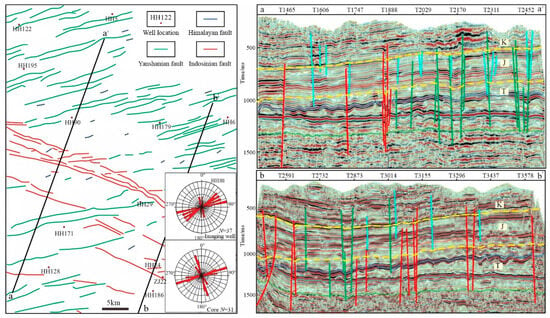
Figure 14.
Phases of fault and fracture development in the Zhenjing area of the Ordos Basin (modified from [77]). (a) a-a’ Seismic profile. (b) b-b’ Seismic profile.
Research on regional geology, geophysics, and fission track thermochronology has revealed multiple tectonic thermal events since the Late Mesozoic, with tectonic activities continuing to the present day [12,33,52,78,79,80,81]. These tectonic activities facilitated the formation of Yanshanian and Indosinian faults, providing pathways for hydrocarbon fluid migration. Concurrently, regional uplift events have also driven the migration of uranium-bearing oxygenated waters. The distribution of sandstone-type uranium deposits in the southern Ordos Basin is closely related to fault structures, with faults and secondary fractures controlling the locations of uranium deposits (Figure 15a,b; [49,52,76,82]).
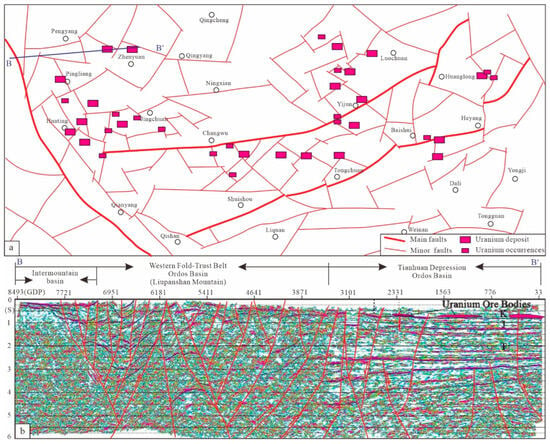
Figure 15.
Spatial distribution relationship between fracture structures and uranium mineralization in the southwestern Ordos Basin. (a) Uranium mineralization is predominantly localized in the vicinity of fracture structures [83]. (b) Fracture structures serve as conduits, facilitating communication between hydrocarbon source rocks and uranium reservoirs [52].
5.4. Metallogenic Mechanism of the Luohe Formation
5.4.1. Formation of Uranium Reservoirs
In the early Cretaceous, the regional paleoclimate transitioned from a humid and warm environment to a hot and arid one [52]. Subsequently, the area remained in a prolonged dry environment, with widespread Cretaceous deposits primarily consisting of aeolian sediments. During the deposition of the Luohe Formation, a thick layer of aeolian sand was deposited in the Ordos Basin, with extensive red sandstone layers forming a favorable uranium reservoir (Figure 2, Figure 3 and Figure 16) [38,84]. The multiple intermittent fluctuations of the paleoclimate during the Cretaceous recorded several advances and retreats of the desert in the basin [85]. Changes in the paleoclimate also led to the formation of a stable “mud–sand–mud” reservoir structure in the Luohe Formation, which is conducive to uranium mineralization [52]. Due to the arid paleoclimate and the dominance of aeolian sedimentary systems in the Luohe Formation, the reservoir is characterized by an extreme lack of reducing media.

Figure 16.
An integrated diagram illustrating the tectonic evolution and uranium mineralization timing of the Ordos Basin.
5.4.2. Injection of Hydrocarbon Fluids
The late Jurassic to early Cretaceous period is the main accumulation period for oil in the Yanchang Formation, with hydrocarbon source rock generation being a continuous process (Figure 16). In the early Cretaceous, the geothermal gradient in the Ordos Basin reached its peak, promoting the maturation of source rocks and the accumulation of oil and gas [86]. After the late early Cretaceous, the basin began to uplift as tectonic activities increased, leading to the gradual development of faults [87]. The secondary migration of oil and gas began, forming Jurassic oil and gas reservoirs [73,88]. With the ongoing tectonic activities, hydrocarbons further dispersed from the Triassic to Jurassic reservoirs [20,72]. Along the fault structures, hydrocarbon fluids progressively entered the Cretaceous uranium reservoirs. Due to the development of sand bodies, the Luohe Formation became an important space for the dispersion of hydrocarbon gases. The original red sandstone of the Luohe Formation was transformed into gray sandstone under the influence of hydrocarbon fluids [40], becoming a reduction barrier that constrains the migration of oxidizing fluids (Figure 17).

Figure 17.
Schematic diagram illustrating the coupled mineralization process involving uranium-bearing oxygen-rich fluids and hydrocarbon-bearing fluids in the southwestern region of the Ordos Basin (modified from [39,44]).
5.4.3. Coupled Mineralization of Oxygenated and Hydrocarbon Fluids
The transition from the preparatory phase to the enrichment phase of sandstone-type uranium mineralization typically involves undergoing tectonic transformation events in the basin [4,11,15,62,71,89,90,91,92]. Since the Mesozoic, the Ordos Basin has experienced multiple tectonic uplift events, with the mineralization of sandstone-type uranium deposits being closely related to these events [89]. Tectonic uplift controls the groundwater recharge–drainage system, with accompanying faults facilitating material transport and providing the driving force for mineralizing fluid migration. The ample uranium sources at the basin margin, driven by tectonic uplift, continuously migrate into the uranium reservoirs with oxygenated fluids. When these fluids encounter the geochemical reduction barriers formed by deep basin hydrocarbon fluids, redox mineralization occurs (Figure 17). The age distribution of sandstone-type uranium deposits in the Ordos Basin also correlates with tectonic transformation events and oil and gas dispersion timings (Figure 16). The sequence of tectonic evolution and its superimposed transformation features in the Ordos Basin during the Cenozoic facilitated the migration of hydrocarbons, providing a sufficient reducing medium for uranium reservoirs in arid sedimentary backgrounds and resulting in a multi-energy coupling mineralization effect.
6. Conclusions
- (1)
- In the southwestern part of the Ordos Basin, uranium minerals in the Lower Cretaceous Luohe Formation are primarily hosted at the edges of sandstone particles or within pores, exhibiting a lump or star-like distribution. The main uranium mineral is pitchblende, with particle sizes concentrated between 2 and 15 μm. The uranium reservoir lacks common reducing agents such as carbonaceous debris and pyrite, but the total hydrocarbon gas content is significantly higher than in uranium reservoirs in other regions of the country, reaching levels 10 to 100 times greater. Therefore, deep hydrocarbon-bearing fluids are the most important reducing agents for uranium mineralization.
- (2)
- In the Cretaceous, the acid decomposition gas components within different sandstone bodies are predominantly methane. Based on relevant characteristic parameters, the hydrocarbon gases in the uranium reservoir are of organic origin, primarily in the low-maturity to high-maturity thermal evolution stage, representing oil cracking gas. These characteristics are consistent with the Triassic Yanchang Formation source rocks, indicating that the hydrocarbon fluids in the Cretaceous uranium reservoirs mainly originate from the Triassic Yanchang Formation source rocks.
- (3)
- Faults from different geological periods, including the Indosinian, Yanshanian, and Himalayan phases, effectively connect the Cretaceous uranium reservoirs with Triassic and Jurassic oil and gas reservoirs, providing pathways for the migration of deep hydrocarbon-bearing fluids into the Cretaceous uranium reservoirs. The distribution of sandstone-type uranium mines in the southern Ordos Basin is closely related to fault structures, with faults and secondary faults controlling the locations of uranium deposits.
- (4)
- The multiphase tectonic evolution since the Cenozoic in the Ordos Basin provides fault pathways for the migration of hydrocarbon-bearing fluids, supplying sufficient reducing agents for uranium reservoirs in an arid sedimentary background, while also facilitating the migration of uranium and oxygen-bearing fluids, resulting in a multi-energy coupling mineralization effect.
Supplementary Materials
The following supporting information can be downloaded at: https://www.mdpi.com/article/10.3390/min15070716/s1, Tabel S1. Results table for the analysis of acid-hydrolyzed hydrocarbons in Lower Cretaceous sandstone from the Zhenyuan region. Table S2. The results of Single Probe Analysis of Uranium Mineral Composition.
Author Contributions
Investigation, J.L. and C.H.; Writing—original draft, T.Z.; Writing—review & editing, X.Z. and Q.W.; Visualization, Y.H. and L.G.; Supervision, L.L.; Funding acquisition, C.L. All authors have read and agreed to the published version of the manuscript.
Funding
This research was funded by the Natural Science Foundation of Heilongjiang Province grant number [LH2022D014].
Data Availability Statement
The original contributions presented in this study are included in the article/Supplementary Material. Further inquiries can be directed to the corresponding author.
Conflicts of Interest
Author Tao Zhang, Jingchao Lei and Cong Hu was employed by the company Exploration Department of Changqing Oilfield Co., Ltd. The remaining authors declare that the research was conducted in the absence of any commercial or financial relationships that could be construed as a potential conflict of interest.
References
- Hu, X.W.; Yang, X.Y.; Ren, Y.S.; Du, G.F.; Wu, Z.J. Genesis of interlayer oxidation zone-type uranium deposit in the channel conglomerates, Beisantai area, Junggar Basin: An insight into uranium mineralization. Ore Geol. Rev. 2022, 140, 104557. [Google Scholar] [CrossRef]
- Huang, G.; Wu, D.; Huang, G.; Xue, W.; Min, Z.; Fan, P. Provenance of Jurassic Sediments from Yuqia Sandstone-Type Uranium Deposits in the Northern Margin of Qaidam Basin, China and Its Implications for Uranium Mineralization. Minerals 2022, 12, 82. [Google Scholar] [CrossRef]
- Huang, S.H.; Qin, M.K.; Guo, Q.; Liu, Z.Y.; Zhang, L.L. Diagenesis of Sand-Mudstone from Qingshankou Formation and Their Uranium Mineralization in DL Deposit, Southwestern Songliao Basin. Earth Sci. 2023, 48, 4441–4464, (In Chinese with English Abstract). [Google Scholar]
- Peng, H.; Jiao, Y.Q.; Fu, X.F.; Wu, L.Q.; Guo, X.D.; Wang, Q.S.; Liu, C. Provenance and uranium source tracing for uranium-bearing series in the south of Songliao Basin: Evidence from zircon U-Pb chronology and lithogeochemistry. J. Geochem. Explor. 2025, 272, 107703. [Google Scholar] [CrossRef]
- Tao, R.; Song, Y.; Duan, L.; Li, M.T. Provenance Analysis Signposts for Sedimentary Uranium Exploration in Aeolian Sandstones Systems: Insight into the Luohe Formation Sandstones Western Ordos Basin. J. Geochem. Explor. 2025, 271, 107672. [Google Scholar] [CrossRef]
- Yin, S.; Yan, Z.B.; Fu, J.L.; Zhang, W.; Liu, H.; Xia, F.; Wang, Q.F. Polymorphic transformations of titanium oxides contribute to economic uranium mineralization in sandstone. Geology 2024, 52, 481–485. [Google Scholar] [CrossRef]
- Zhang, Y.Y.; Chen, Y.L.; Li, D.P.; Kang, H.; Fang, M.L.; Xu, Y.L. Tracing Sources of Geochemical Anomalies in a Deeply Buried Volcanic-Related Hydrothermal Uranium Deposit: The Daguanchang Deposit Northern Hebei Province North China Craton. J. Earth Sci. 2024, 35, 1186–1195. [Google Scholar] [CrossRef]
- Dahlkamp, F.J. Uranium Ore Deposits; Springer: Berlin, Germany, 1993; pp. 1–460. [Google Scholar]
- Granger, H.C.; Warren, C.G. Unstable sulfur compounds and the origin of roll-type uranium deposits. Econ. Geol. 1969, 64, 160–171. [Google Scholar] [CrossRef]
- Peng, H.; Jiao, Y.Q.; Dong, F.S.; Guo, X.D. Relationships between uranium occurrence, pyrite and carbonaceous debris in Fuxin Formation in the Songliao Basin: Evidenced by mineralogy and sulfur isotopes. Ore Geol. Rev. 2022, 140, 104580. [Google Scholar] [CrossRef]
- Peng, H.; Jiao, Y.Q.; Rong, H.; Pang, B.; Lv, D.L.; Guo, X.D.; Wang, Q.S.; Yuwen, X.Y. Spatial-Temporal Coupling of Key Ore-Controlling Factors for Sandstone-Type Uranium Deposits in Tiefa Area, Songliao Basin. Earth Sci. 2024, 49, 3182–3198, (In Chinese with English Abstract). [Google Scholar]
- Tian, M.M.; Li, Z.Y.; Zhang, Y.L.; Jia, L.C.; Ning, J.; Li, J.M.; He, H.H.; Tang, G.L. Genetic mechanism of tabular-shaped orebody of the hailijin sandstone-type uranium deposit in the songliao basin: Constraints on the clay mineralogy of ore-bearing sandstone. Minerals 2023, 13, 1324. [Google Scholar] [CrossRef]
- Tian, Z.Y.; Chen, H.; Liu, X.S.; Gong, W.B.; Zhao, W.B.; Kang, R. Fission track ages Mesozoic tectonic uplift in the Niushoushan—Luoshan area on the western edge of the Ordos Basin. J. Geomech. 2023, 29, 599–617, (In Chinese with English Abstract). [Google Scholar]
- Wang, Q.S.; Peng, H.; Liu, C.; Zhang, Z.Y.; Zhou, Y.H.; Guo, X.D.; Ju, N.; Fu, Q.L.; Hao, Y. Constraints of reducing media on uranium mineralization in the uranium-bearing rock systems of the southern Songliao basin. Ore Geol. Rev. 2025, 176, 106406. [Google Scholar] [CrossRef]
- Jiao, Y.Q.; Wu, L.Q.; Peng, Y.B.; Rong, H.; Ji, M.D.; Miao, A.S.; Li, H.L. Sedimentary-tectonic setting of the deposition-type uranium deposits forming in the Paleo-Asian tectonic domain, North China. Earth Sci. Front. 2015, 22, 189–205, (In Chinese with English Abstract). [Google Scholar]
- Wu, B.L.; Liu, C.Y.; Yang, S.L.; Wang, M.; Li, Q.; Lin, Z.Y.; Zhang, X.R.; Li, Y.Q.; Zhang, W.Y.; Liu, M.Y. Mechanistic and progress of uranium mineralization by organic minerals (oil, gas and coal) in sedimentary basins. J. Northwest Univ. (Nat. Sci. Ed.) 2022, 52, 1044–1065, (In Chinese with English Abstract). [Google Scholar]
- Cai, Y.L.; Ouyang, F.; Luo, X.R.; Zhang, Z.L.; Wen, M.L.; Luo, X.N.; Tang, R. Geochemical Characteristics and Constraints on Provenance, Tectonic Setting, and Paleoweathering of Middle Jurassic Zhiluo Formation Sandstones in the Northwest Ordos Basin, North-Central China. Minerals 2022, 12, 603. [Google Scholar] [CrossRef]
- Feng, Z.B.; Nie, F.J.; Jiang, L.; Xia, F.; Cai, J.F.; Zhang, B.C.; Lu, Y.Y.; Zhang, L.L. Roles of Multisourced Fluids in the Formation of Sandstone-Hosted Uranium Deposits in the SW Songliao Basin, NE China. J. Earth Sci. 2023, 34, 54–69. [Google Scholar] [CrossRef]
- Li, J.G.; Zhang, B.; Jin, R.S.; Si, Q.H.; Miao, P.S.; Li, H.L.; Cao, M.Q.; Wei, J.L.; Chen, Y. Uranium Mineralization of Coupled Supergene Oxygen-Uranium Bearing Fluids and Deep Acidic Hydrocarbon Bearing Fluids in the Qianjiadian Uranium Deposit, Kailu Basin. Geotecton. Metallog. 2020, 44, 576–589, (In Chinese with English Abstract). [Google Scholar]
- Li, X.B.; Liu, X.Y.; Zhou, S.X.; Liu, H.Q.; Chen, Q.L.; Wang, Q.; Liao, J.B.; Huang, J.P. Hydrocarbon origin and reservoir forming model of the lower yanchang Formation, Ordos Basin. Pet. Explor. Dev. 2012, 39, 184–193, (In Chinese with English Abstract). [Google Scholar] [CrossRef]
- Qin, M.K.; Huang, S.H.; Liu, J.L.; Liu, Z.Y.; Guo, Q.; Jia, L.C.; Jiang, W.J. Hydrothermal Alteration and Its Superimposed Enrichment for Qianjiadian Tabular-Type Uranium Deposit in Southwestern Songliao Basin. Minerals 2022, 12, 52. [Google Scholar] [CrossRef]
- Xue, C.J.; Chi, G.X.; Xue, W. Interaction of two fluid systems in the formation of sandstone-hosteduranium deposits in the Ordos Basin: Geochemical evidence hydrodynamic modeling. J. Geochem. Explor. 2010, 106, 226–235. [Google Scholar] [CrossRef]
- Xue, C.J.; Chi, G.X.; Xue, W. Effects of hydrocarbon generation on fluid flow in the Ordos Basin and itsrelationship to uranium mineralization. Geosci. Front. 2011, 2, 439–447. [Google Scholar] [CrossRef]
- Yan, Z.B.; Zhang, W.W.; Zhang, C.Y.; Xia, F.; Niu, F.J.; Wu, X.Y. The influence of deep fluid activity in the basin on the metallogenic process of sandstone-type uranium deposits. Acta Geol. Sin. 2023, 97, 4131–4149, (In Chinese with English Abstract). [Google Scholar]
- Zhang, L.; Liu, C.Y.; Fayek, M.; Wu, B.L.; Lei, K.Y.; Cun, X.N.; Sun, L. Hydrothermal mineralization in the sandstone-hosted Hangjinqi uranium deposit, North Ordos Basin, China. Ore Geol. Rev. 2017, 80, 103–115. [Google Scholar] [CrossRef]
- Zhang, L.; Liu, C.Y.; Lei, K.Y. Green altered sandstone related to hydrocarbon migration from the uranium deposits in the northern Ordos Basin, China. Ore Geol. Rev. 2019, 109, 482–493. [Google Scholar] [CrossRef]
- Zhang, Y.C.; Rong, H.; Jiao, Y.Q.; Cao, M.Q.; Li, Q.C.; Guo, L.L.; Guo, C.Q.; Zhou, M.W. Occurrence State of Fe-Ti Oxides and Its Response to Uranium Mineralization Process in Interlayer Oxidation Zone of Qianjiadian Uranium Deposit. Earth Sci. 2024, 49, 2024–2043, (In Chinese with English Abstract). [Google Scholar]
- Ao, C.; Teng, X.M.; Wei, X.B.; Lei, T.; Wang, D.; Yang, J. Geochemistry of Mudstones/Silty Mudstones from the Qigequan Formation and Shizigou Formation in Yuejin-II Area, Southwestern Area of the Qaidam Basin: Implications for Sedimentary Environment and Sandstone-Type Uranium Mineralization. Minerals 2022, 12, 658. [Google Scholar] [CrossRef]
- Bonnetti, C.; Cuney, M.; Malartre, F.; Miachels, R.; Liu, X.D.; Peng, Y.B. The Nuheting deposit, Erlian Basin, NE China: Synsedimentary to diagenetic uranium mineralization. Ore Geol. Rev. 2015, 69, 118–139. [Google Scholar] [CrossRef]
- Bonnetti, C.; Zhou, L.; Riegler, T.; Brugger, J.; Fairclough, M. Large S Isotope and Trace Element Fractionations in Pyrite of Uranium Roll Front Systems Result from Internally-driven Biogeochemical Cycle. Geochim. Cosmochim. Acta 2020, 282, 113–132. [Google Scholar] [CrossRef]
- Min, M.; Xu, H.; Jia, C.; Fayek, M. Evidence of Uranium Biomineralization in Sandstone-hosted Roll-front Uranium Deposits, Northwestern China. Ore Geol. Rev. 2005, 26, 198–206. [Google Scholar] [CrossRef]
- Rong, H.; Jiao, Y.Q.; Wu, L.Q.; Wan, D.; Cui, Z.J.; Guo, X.J.; Jia, J.M. Origin of the carbonaceous debris and its implication for mineralization within the Qianjiadian uranium deposit, southern Songliao Basin. Ore Geol. Rev. 2019, 107, 336–352. [Google Scholar] [CrossRef]
- Yue, L.; Jiao, Y.Q.; Fayek, M.; Wu, L.Q.; Rong, H.; Xie, H.L. Transformation of Fe-bearing minerals from Dongsheng sandstone-type uranium deposit, Ordos Basin, north-central China: Implications for ore genesis. Am. Mineral. 2022, 107, 1396–1409. [Google Scholar] [CrossRef]
- Yue, L.; Jiao, Y.Q.; Wu, L.Q.; Rong, H. Quantitative characterization on multistage formation of sedimentary pyrite driven by H2S derived from biogenic process in the northeastern Ordos Basin, China. Sediment. Geol. 2024, 473, 106768. [Google Scholar] [CrossRef]
- Yue, L.; Jiao, Y.Q.; Wu, L.Q.; Rong, H.; Xie, H.L.; Wang, Q.Y.; Yan, Q.Q. Selective crystallization and precipitation of authigenic pyrite during diagenesis in uranium reservoir sandbodies in Ordos Basin. Ore Geol. Rev. 2019, 107, 532–545. [Google Scholar] [CrossRef]
- Zhang, F.; Jiao, Y.Q.; Wu, L.Q.; Rong, H.; Wang, J.Y.; Zhang, C.C. Geochemical characteristics of uranium-rich dispersed organic matter their geological significance for uranium mineralization: A case study from the Ordos Basin. J. Geochem. Explor. 2024, 264, 107528. [Google Scholar] [CrossRef]
- Zhang, P.C.; Yu, C.Q.; Zeng, X.Z.; Tan, S.J.; Lu, C. Ore-controlling structures of sandstone-hosted uranium deposit in the southwestern Ordos Basin: Revealed from seismic and gravity data. Ore Geol. Rev. 2022, 140, 104590. [Google Scholar] [CrossRef]
- Jin, R.S.; Zhu, Q. Supernormal enrichment mechanism and metallogenic process of sandstone type uranium deposit in the eolian sedimentary system in Jingchuan area, Ordos basin. Acta Geol. Sin. 2023, 3, 725–737, (In Chinese with English Abstract). [Google Scholar]
- Miao, P.S.; Chen, Y.; Cheng, Y.H.; Zhao, H.L.; Chen, L.; Li, J.G.; Jin, R.S.; Tang, C.; Yu, R.A.; Yang, T. New Deep Exploration Discoveries of Sandstone-type Uranium Deposits in North China. Geotecton. Metallog. 2020, 44, 563–575, (In Chinese with English Abstract). [Google Scholar]
- Si, Q.H.; Li, J.G.; Miao, P.S.; Zhang, C.; Zhu, Q.; Zhao, H.L. Characteristics and mechanism of hydrocarbon alteration of faded sandstone in the uranium-bearing Luohe Formation, Pengyang area, southwestern Ordos Basin. Ore Geol. Rev. 2021, 139, 104500. [Google Scholar] [CrossRef]
- Zhu, Q.; Li, J.G.; Wen, S.B. Alteration, uranium occurrence state, and enrichment mechanism of the Cretaceous Luohe Formation, southwestern Ordos Basin, western China. Ore Geol. Rev. 2021, 139, 104486. [Google Scholar] [CrossRef]
- Akhtar, S.; Yang, X.; Pirajno, F. Sandstone type uranium deposits in the Ordos Basin Northwest China: A case study an overview. J. Asian Earth Sci. 2017, 146, 367–382. [Google Scholar] [CrossRef]
- Jin, R.S.; Teng, X.M.; Li, X.G.; Si, Q.H.; Wang, W. Genesis of sandstone-type uranium deposits along the northern margin of the Ordos Basin, China. Geosci. Front. 2020, 11, 215–227. [Google Scholar] [CrossRef]
- Jaireth, S.; McKay, A.; Lambert, I. Association of Large Sandstone Uranium Deposits with Hydrocarbons. AusGeo News 2008, 89, 1–6. [Google Scholar]
- Li, Q.; Wu, B.L.; Luo, J.J.; Yang, S.L.; Wang, M.; Liu, M.Y.; Lin, Z.Y.; Zhang, X.R.; Zhang, L.; Wang, J.Q. Characters and Metallogenetic Significance of Organic Matter in Coal from the Daying Sandstone-Hosted Uranium Deposit in the Northern Ordos Basin, China. Minerals 2023, 13, 1002. [Google Scholar] [CrossRef]
- Ren, Y.S.; Yang, X.Y.; Miao, P.S.; Hu, X.W.; Chen, Y.; Chen, L.L.; Zhao, H.L. Mineralogical and geochemical research on Pengyang deposit: A peculiar eolian sandstone-hosted uranium deposit in the southwest of Ordos Basin. Ore Geol. Rev. 2022, 141, 104571. [Google Scholar] [CrossRef]
- Zhang, F.; Jiao, Y.Q.; Liu, Y.; Wu, L.Q.; Rong, H. Traces of hydrocarbon-bearing fluid and microbial activities and their implications for uranium mineralization in southern Ordos Basin, China. Ore Geol. Rev. 2021, 139, 104525. [Google Scholar] [CrossRef]
- Hao, R.L.; Huang, W.H.; Bo, J.; Yuan, L. Fractal Characteristics Main Controlling Factors of High-Quality Tight Sandstone Reservoirs in the Southeastern Ordos Basin. J. Earth Sci. 2024, 35, 631–641. [Google Scholar] [CrossRef]
- Liu, X.Y.; Guo, W.; Liu, J.Y.; Li, S.X. Characteristics and Exploration Prospects of Deep-Water Sandstone Reservoir of Chang 73 Sub-Member, Ordos Basin. Earth Sci. 2023, 48, 279–292, (In Chinese with English Abstract). [Google Scholar]
- Lu, H.; Li, Q.; Yue, D.; Xia, D.D.; Wu, S.H.; Wen, L.; He, Y. Multi-Scale Pore Structure Heterogeneity in Tuff Reservoirs Investigated with Multi-Experimental Method Fractal Dimensions in Chang 7 Formation Southern Ordos Basin. J. Earth Sci. 2024, 35, 666–686. [Google Scholar] [CrossRef]
- Wang, Z.; Gong, Y.M. Composition and Construction of High- and Low-Energy Ooid Shoals and Their Relationships with Environmental Changes: A Case Study from the Cambrian Zhangxia Formation in the Ordos Basin, North China. J. Earth Sci. 2023, 34, 156–172. [Google Scholar] [CrossRef]
- Chen, Y.; Li, J.G.; Miao, P.S.; Chen, L.L.; Zhao, H.L.; Wang, C.; Yang, J. Relationship between the tectono-thermal events and sandstone-type uranium mineralization in the southwestern Ordos Basin, Northern China: Insights from apatite and zircon fission track analyses. Ore Geol. Rev. 2022, 143, 104792. [Google Scholar] [CrossRef]
- Ding, B.; Liu, H.X.; Xu, D.R.; Qiu, L.F.; Zhang, Z.L.; He, F. Uranium Metallogenic Effect of Hydrothermal Fluid Transformation in Sandstone-Type Uranium Deposits in Northern Ordos Basin: Constraints from the Study of Biotite Chloritization Process. Earth Sci. 2024, 49, 625–638, (In Chinese with English Abstract). [Google Scholar]
- Liu, Y.; Yang, S.; Yin, Y.P.; Wang, J.L.; Hao, G.Q. Hydrocarbon Fluid Feature of the Shangyoushashan Formation Sandstone in the Northwest Qaidam Basin and its Relationship to Uranium Mineralization. J. East China Univ. Technol. (Nat. Sci.) 2020, 43, 430–436, (In Chinese with English Abstract). [Google Scholar]
- Huang, Y.Q.; Wu, M.Q.; Yang, J.W.; Teng, X.M.; Ao, C.; Bishikwabo, G.K.; Qiu, K.F. Sedimentary and ore-forming characteristics of uranium mineralization in the Shizigou formation from the Southwest Qaidam Basin, Northwest China. Ore Geol. Rev. 2025, 179, 106534. [Google Scholar] [CrossRef]
- Li, Z.Y.; Fang, X.H.; Chen, A.P.; Ou, G.X.; Xiao, X.J.; Sun, Y.; Liu, C.Y.; Wang, Y. The genesis of gray-green sandstone in the target layer of sandstone-type uranium deposit in the northern Ordos Basin. Sci. Sin. (D: Terrae) 2007, 37, 139–146. (In Chinese) [Google Scholar]
- Luo, M.; Li, J.Y.; Liu, X.H.; Lu, S.J. Sandstone of Sifangtai Formation in the Western Slope of Songliao Basin: Relation Between Hydrocarbon Fluid Characteristics and Uranium Mineralization. Geol. Resour. 2021, 30, 118–125, (In Chinese with English Abstract). [Google Scholar]
- Zhao, H.L.; Li, J.G.; Si, Q.H.; Yu, R.G.; Miao, P.S.; Chen, L.L.; Chen, Y.; Zhang, B. Characteristics of fluid inclusions and fluid coupling mineralization of the Pengyang uranium deposit, Ordos Basin. Ore Geol. Rev. 2022, 148, 105043. [Google Scholar] [CrossRef]
- Hill, R.J.; Tang, Y.C.; Kaplan, I.R. Insightsinto oil crackingbased on laboratory experiments. Org. Geochem. 2003, 34, 1651–1672. [Google Scholar] [CrossRef]
- Zhang, M.; Huang, G.H.; Hu, G.Y.; Zhao, H.J. Geochemical study on oil cracked gases and kerogen-cracked gases (I)—Experimental simulation and products analysis. Sci. China Ser. D Earth Sci. 2009, 52, 1–9. [Google Scholar] [CrossRef]
- Wang, S.Y.; Cheng, Y.H.; Jin, R.S.; Miao, P.S.; Zhang, T.F.; Xu, Z.L.; Ao, C.; Teng, X.M.; Cheng, X.Y. Detrital zircon U-Pb ages of the cretaceous strata in the southern Songliao Basin, NE China: Constraints on basin-and-range evolution. Sediment. Geol. 2022, 433, 106133. [Google Scholar] [CrossRef]
- Gao, G.; Wang, Y.B.; Han, D.X.; Shi, J.; Pu, X.G. Comparison of characteristics of coal hydrothermal simulation gas. Earth Environ. 2003, 31, 92–96, (In Chinese with English Abstract). [Google Scholar]
- Wang, Y.P.; Tian, J. Review of oil cracked gas formation, identification and migration. Nat. Gas Geosci. 2007, 18, 235–244, (In Chinese with English Abstract). [Google Scholar]
- Prinzhofer, A.A.; Huc, A.Y. Geneticand post-genetic molecular and isotopic fractionations in natural gases. Chem. Geol. 1995, 126, 281–290. [Google Scholar] [CrossRef]
- Liu, D.; Li, J.; Liu, J.Q.; Zhang, L. Modeling hydrocarbon accumulation based on gas origin and source rock distribution in paleozoic strata of the ordos basin, China. Int. J. Coal Geol. 2020, 225, 103486. [Google Scholar] [CrossRef]
- Wang, Q.T.; Liu, W.H.; Meng, P.L.; Hu, J.L.; Wang, X.F.; Zhang, D.D.; Liu, J.Z. Assessment the gas potential of coal-bearing mudstones from upper paleozoic in ordos basin via gold-tube pyrolysis. J. Nat. Gas Sci. Eng. 2021, 90, 103895. [Google Scholar] [CrossRef]
- Guo, Y.R.; Liu, J.B.; Yang, H.; Liu, Z.; Fu, J.H.; Yao, J.L.; Xu, W.L.; Zhang, Y.L. Hydrocarbon accumulation mechanism of low permeable tight lithologic oil fields in the Yanchang Formation, Ordos Basin, China. Pet. Explor. Dev. Online 2012, 39, 447–456. [Google Scholar] [CrossRef]
- Zou, C.N.; Yang, Z.; Tao, S.Z.; Yuan, X.J.; Zhu, R.K.; Hou, L.H.; Wu, S.T.; Sun, L.; Zhang, G.S.; Bai, B. Continuous hydrocarbon accumulation over a large area as a distinguishing characteristic of unconventional petroleum: The ordos basin, north-central china. Earth Sci. Rev. 2013, 126, 358–369. [Google Scholar] [CrossRef]
- Zhang, P.H. Coalbed methane(CBM) development potential of low rank coal: A case study from Ordos Basin. Coal Geol. Explor. 2007, 35, 29–33. [Google Scholar]
- Wang, D.D.; Shao, L.Y.; Li, Z.X.; Li, M.P.; Lv, D.; Liu, H. Hydrocarbon generation characteristics, reserving performance and preservation conditions of continental coal measure shale gas: A case study of mid-jurassic shale gas in the Yanan Formation, ordos basin. J. Pet. Sci. Eng. 2016, 145, 609–628. [Google Scholar] [CrossRef]
- Liu, X.S.; Xi, S.L.; Huang, D.J.; Zhang, Q.; Wang, X. Dynamic conditions of Mesozoic petroleum secondary migration, Ordos Basin. Pet. Explor. Dev. 2008, 35, 143–147. [Google Scholar] [CrossRef]
- Ye, B.; Liang, X.W.; Song, J.; Cao, R.R.; Mao, Z.H.; Hao, B.Y. Reservoir accumulation characteristies of Jurassic Yanan Formationin Yanwu area, Ordos Basin. Lithol. Reserv. 2018, 30, 65–73, (In Chinese with English Abstract). [Google Scholar]
- Du, X.Y.; Jin, Z.J.; Zeng, L.B.; Li, S.X.; Liu, G.P.; Liang, X.P.; Lu, G.Q. Development Characteristics and Controlling Factors of Natural Fractures in Chang 7 Shale Oil Reservoir, Longdong Area, Ordos Basin. Earth Sci. 2023, 48, 2589–2600, (In Chinese with English Abstract). [Google Scholar]
- He, F.Q.; Qi, R.; Yuan, C.Y.; Yang, F.; Li, X.W. Further Understanding of Relationship between Fault Characteristics and Hydrocarbon Accumulation in Binchang Area, Ordos Basin. Earth Sci. 2024, 49, 4082–4097, (In Chinese with English Abstract). [Google Scholar]
- Yin, S.; Ding, W.L.; Lin, L.F.; Liu, H.L.; Li, A.R. Characteristics and Controlling Effect on Hydrocarbon Accumulation of Fractures in Yanchang Formation in Zhidan-Wuqi Area, Western Ordos Basin. Earth Sci. 2023, 48, 2614–2629, (In Chinese with English Abstract). [Google Scholar]
- Liu, Y.T.; Dai, S.H.; Zhou, Y.J.; Ding, F.F.; Li, M.J.; Zhao, Y.; Guo, B.H.; Li, T.; Han, J.N. Fault characteristics and their control on oil and gas accumulation in the southwestern Ordos Basin. Energy Geosci. 2024, 5, 100151. [Google Scholar] [CrossRef]
- Yang, G.L.; Ren, Z.L.; He, F.Q.; Zhang, Y.Y.; Wang, B.J.; Qi, K. Fault-fracture body growth and hydrocarbon enrichment of the Zhenjing area, the southwestern margin of the Ordos Basin. Oil Gas Geol. 2022, 43, 1382–1396, (In Chinese with English Abstract). [Google Scholar]
- Peng, H.; Wang, J.Q.; Liu, C.Y.; Zhang, S.H.; Zattin, M.; Wu, N.; Feng, Q. Thermochronological constraints on the Meso-Cenozoic tectonic evolution of the Haiyuan-Liupanshan region, northeastern Tibetan Plateau. J. Asian Earth Sci. 2019, 183, 103966. [Google Scholar] [CrossRef]
- Yu, R.A.; Li, T.; Yang, T.X.; Zhao, H.L.; Tu, J.R.; Hu, Y.X.; Tang, Y.X. Provenance and Tectonic Evolution of the Middle and Lower Jurassic Strata Constraints on the Uranium Mineralization in Southwest Margin of Ordos Basin. Earth Sci. 2024, 49, 1793–1809. [Google Scholar]
- Zhao, M.W.; Behr, H.J.; Ahrendt, H.; Wemmer, K. Thermal and tectonic history of the Ordos Basin, China; evidence from apatite fission track analysis, vitrinite reflectance, and K-Ar dating. AAPG Bull. 1996, 80, 1110–1134. [Google Scholar]
- Zheng, D.; Zheng, P.Z.; Wan, J.L.; Yuan, D.; Li, C.Y.; Yin, G.; Zhang, G.L.; Wang, Z.C.; Min, W.; Chen, J. Rapid exhumation at ~8 Ma on the Liupan Shan thrust fault from apatite fission-track thermochronology: Implications for growth of the northeastern Tibetan Plateau margin. Earth Planet. Sci. Lett. 2006, 248, 198–208. [Google Scholar] [CrossRef]
- Yang, Y.H.; Ye, F.W.; Mu Mu, H.X.; Wu, D.; Yang, G.F.; Li, X.C.; Gan, Q.Q. Remote sensing identification of metallogenic elements of sandstone-type uranium deposits in Huanxian area, southwestern Ordos Basin. World Nucl. Geosci. 2024, 41, 573–583, (In Chinese with English Abstract). [Google Scholar]
- Ma, X.L. The Relationship Between Geophysical Field Characteristics and Sandstone-Type Uranium Deposits in Southwestern Ordos Basin. Master’s Thesis, Xi’an Shiyou University, Xi’an, China, 2016. (In Chinese with English Abstract). [Google Scholar]
- Zhu, Q.; Si, Q.H.; Li, J.G.; Miao, P.S.; Wen, S.B.; Li, G.Y.; Zhang, B. Two genesis and uranium-bearing property of grey sandstone of Lower Cretaceous Luohe Formation in southwestern Ordos Basin. Earth Sci. 2023, 48, 3995–4016, (In Chinese with English Abstract). [Google Scholar]
- Xiang, Y.; Jiao, Y.Q.; Wu, L.Q.; Rong, H.; Zhang, F. Markers and genetic mechanisms of primary and epigenetic oxidation of an aeolian depositional system of the Luohandong Formation, Ordos Basin. J. Earth Sci. 2022, 33, 358–372. [Google Scholar] [CrossRef]
- Ren, Z.L.; Qi, K.; Liu, R.C.; Liu, R.C.; Cui, J.P.; Chen, Z.P.; Zhang, Y.Y.; Yang, G.L.; Ma, S. Dynamic background of Early Cretaceous tectonic thermal events and its control on various mineral accumulations such as oil and gas in the Ordos Basin. Acta Pet. Sin. 2020, 36, 1213–1234, (In Chinese with English Abstract). [Google Scholar]
- Li, Y.Y.; Shang, Y.J.; Peng, Y. Modeling fracture connectivity in naturally fractured reservoirs: A case study in the Yanchang Formation, Ordos Basin, China. Fuel 2018, 211, 789–796. [Google Scholar] [CrossRef]
- Liu, X.; Wang, F.; Liu, B.J.; Tian, J.C.; Shang, T. Factors Controlling Hydrocarbon Accumulation in Jurassic Reservoirs in the Southwest Ordos Basin, NW China. Acta Geol. Sin. (Engl. Ed.) 2020, 94, 253–270. [Google Scholar] [CrossRef]
- Cheng, Y.H.; Jin, R.S.; Miao, P.S.; Wang, S.Y.; Teng, X.M. Two Metallogenic Models of Sedimentary-Hosted Uranium Deposit: Jingchuan and Tale Types. Earth Sci. 2025, 50, 46–57, (In Chinese with English Abstract). [Google Scholar]
- Cheng, Y.H.; Wang, S.Y.; Jin, R.S.; Li, J.G.; Ao, C.; Teng, X.M. Global Miocene tectonics andregional sandstone-style uranogenic mineralization processes. Ore Geol. Rev. 2019, 106, 238–250. [Google Scholar] [CrossRef]
- Cheng, Y.H.; Wang, S.Y.; Zhang, T.F.; Teng, X.M.; Ao, C.; Jin, R.S.; Li, H.L. Regional sandstone-hosteduranogenic mineralization processes rooted in Oligo-Miocene tectonic inversion in the Songliao Basin, NE China. Gondwana Res. 2020, 88, 88–105. [Google Scholar] [CrossRef]
- Wang, S.Y.; Cheng, Y.H.; Xu, D.H.; Miao, P.S.; Jin, R.S.; Zhang, T.F.; Xu, Z.L.; Cheng, X.Y.; Zhao, L.; Li, C.H. Late Cretaceous-Cenozoic tectonic sedimentary evolution and U-enrichment in the southern Songliao Basin. Ore Geol. Rev. 2020, 126, 103786. [Google Scholar] [CrossRef]
Disclaimer/Publisher’s Note: The statements, opinions and data contained in all publications are solely those of the individual author(s) and contributor(s) and not of MDPI and/or the editor(s). MDPI and/or the editor(s) disclaim responsibility for any injury to people or property resulting from any ideas, methods, instructions or products referred to in the content. |
© 2025 by the authors. Licensee MDPI, Basel, Switzerland. This article is an open access article distributed under the terms and conditions of the Creative Commons Attribution (CC BY) license (https://creativecommons.org/licenses/by/4.0/).